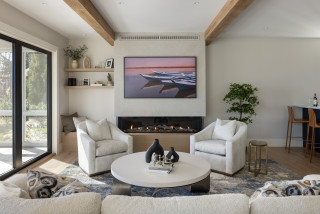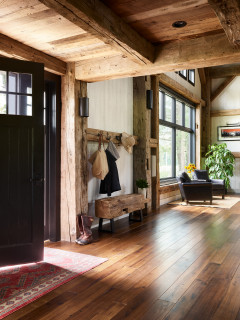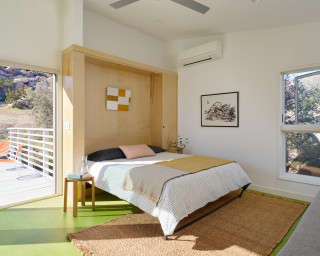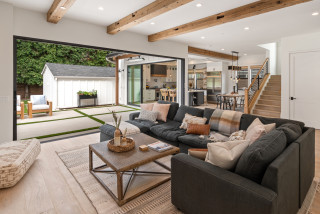
This article was originally published by a www.houzz.com . Read the Original article here. .

This article was originally published by a www.houzz.com . Read the Original article here. .

I think of this as the first-aid kit phenomenon: When you need a Band-Aid, you may also need some antibiotic ointment, maybe some tweezers to remove a splinter, and a gauze pad. In a first-aid kit, everything you need to complete the task of caring for your injury is conveniently located in one place.
When you’re organizing your stuff, remember this and group everything you need to complete a task in the same place. For example, you could make one box for medications, another for spare office supplies, one for holiday cookie cutters and sprinkles, and so on. Labeled shoebox-size boxes, buckets or baskets work well for grouping small items together.
This article was originally published by a www.houzz.com . Read the Original article here. .

Getting ready to host overnight guests? Let’s assume you have a bed (or air mattress) and coverings on all the windows. That’s a great start! This list will help fill in all the little things your guests will want to have on hand for a comfortable night’s sleep. What you won’t find here: season-specific decor, extra charging cords, books and other optional extras that your guests might enjoy but can live without. Instead the focus is on versatile, key pieces to get your guest space up and running so you’re ready for visitors, no matter when they arrive.
Needing a glass of water but not knowing where to get one can be frustrating and uncomfortable for guests. And after traveling by car or plane, they probably need to hydrate. Be prepared with a glass carafe filled with water, and add an extra glass if you’ll be hosting a couple.
Find carafes in the Houzz Shop
Since your guest bed is probably used far less often than the primary bed, there’s no need to go all-out with top-of-the-line bedding (unless you want to). But a good-quality set of percale or sateen sheets and a quilt or duvet in a coordinating hue will make your guests feel well cared for. A neutral palette will look appropriate year-round.
Shop for bedding on Houzz
Good lighting is key to making your guest room feel welcoming. At minimum, place a lamp on each bedside table. Lamps with three settings are ideal so guests can adjust the light levels to suit their preference.
Browse lamps on Houzz
Your guests will appreciate having a simple full-length mirror propped against the wall or attached to the back of the door. If the mirror is in a dark corner of the room, draping a strand of white twinkle lights on it is a quick and inexpensive way to add a warm glow.
Find full-length mirrors in the Houzz Shop
Help out your guests by providing a few extra blankets and pillows so they can get comfortable. This is especially important on chilly winter nights, but if you have central air conditioning, your guests may reach for an extra blanket even in summer!
Shop for bed pillows
A wastebasket is a small but important detail that will help your guests keep their room neat without having to make frequent trips to garbage cans in other parts of the house. Whether you opt for brass, mirrored or woven, choose an attractive wastebasket that enhances your guest room style.
Browse pretty wastebaskets
Have a few spare sample-size toiletries in a drawer? Gather them together in a pretty bowl or basket and add a new toothbrush so guests won’t stress if they forgot something.
A stack of fluffy white bath towels on the bed is a welcoming touch. Be sure to include a wash cloth, hand towel and bath towel for each person.
Shop for bath towels on Houzz
Unless your guests are staying for a week or more, they probably don’t need an empty dresser to unpack their clothes into. A few sturdy wall hooks will do for hanging damp towels and (with the addition of a hanger or two) wrinkle-prone outfits.
Find wall hooks in the Houzz Shop
Considerate guests won’t want to bother you if they get up before you do. Including a little tray with everything they need to make a morning cuppa makes it clear they are welcome to help themselves.
Browse coffee and tea makers
This article was originally published by a www.houzz.com . Read the Original article here. .

When I was growing up, my childhood living room was strictly off-limits to kids and reserved for my parents and their friends. In my current home, however, we do quite a bit of living in our living room. Therefore, having a lighting plan that covers all of my family’s activities in our living room is essential. My plan for a well-lit living room requires five layers of light.
Find an interior designer near you
We all use our living rooms differently, and that means you can benefit from carefully considering what common tasks you and your family perform in the living room before choosing lighting. Do you like to read? If so, good table lamps or floor lamps are a must. Prefer to watch television? Lamps might reflect on the screen, so dimmable downlights might offer a better solution. Playing games with friends? A brighter living room illuminated with both lamps and downlights can make interactions more enjoyable.
Shop for lighting products on Houzz
It’s important to know where you are and where you are going, and general ambient light can help. If you live with other people or have company in your living room, it is equally important to be able to see their faces. In a living room, good ambient light can come from wall sconces, which help define the scope of the room, from a few well-placed lamps at head-level to better see faces and from a ceiling cove overhead that diffuses light throughout the room.
During a sunny day, a living room with abundant natural light flowing through windows can help us feel good. At night, however, we need to replace daylight with a layer of light that will make our space feel more comfortable and relaxing. Light for feeling can come from accent lamps, wall sconces, recessed downlights that highlight stone features, fireplaces and even from table lamps with soft, glowing shades.
We watch movies, read books, play games, work on our laptops, enjoy a fire and converse with friends in our living room. We keep the lights low for movies, higher for playing games and in between when relaxing with friends. Light for changing helps us adapt to tasks, the location of the sun and aging eyes. This might mean different lamps for different tasks and different times of day, or it can be achieved by adding dimmers that allow you to customize light from moment to moment.
Finally, the lights in your living room can help tell your story, revealing your style and the items you cherish most. A spotlight on a painting by a friend lets everyone know you value both art and friendship, while a beautiful Tiffany lampshade might tell of your appreciation for artistry and color.
Choosing the style of decorative fixtures that fits you best is a great way to reveal your style, but decorative fixtures are not the only way to tell your story. Carefully hidden lights on a timber-framed ceiling disappear into the woodwork but highlight the craftsmanship of the structure without adding visual clutter to a room. Concealed lights in bookcases showcase collected items while adding a beautiful glow to the space.
More on Houzz
Read more stories about lighting
Get living room design ideas
Find a designer to help you plan your lighting
Shop for new lighting
This article was originally published by a www.houzz.com . Read the Original article here. .

It’s a rare living room that doesn’t call for an area rug. Even in a carpeted room, an area rug helps to define a seating area and make a room feel complete. So if you don’t already have an area rug, or the one you have doesn’t reflect your current taste, this is a good opportunity for a refresh.
If you’re trying to make a formal living space feel more casual, consider a flat-woven or natural-fiber rug (such as jute). Tufted rugs with asymmetrical patterns or high-low textures are good bets if you’re looking to add a contemporary element to your room. Color-wise, light colors tend to make a room feel larger while darker colors make it feel more cozy. And the busier the patterns of your other textiles, the simpler your rug can be, and vice versa.
At least as important as the style of your rug is its size. A common recommendation is that all of the legs of your furniture — or at least the front legs of your seating — should be on the rug. If you love your current rug but it’s too small or irregularly shaped, you can layer it on top of a larger one. Natural-fiber rugs or solid, neutral-toned wool rugs are often good, affordable choices as base layers. A small, vibrant but well-worn antique Persian or Moroccan rug can look gorgeous over a large jute rug, for example.
All of that said, the “perfect rug” isn’t a specific size or style. It’s the one that most appeals to you and fits your lifestyle and budget.
11 Area Rug Rules and How to Break Them
Shop for an area rug
This article was originally published by a www.houzz.com . Read the Original article here. .

This is an obvious one but it’s worth emphasizing: Comfortable furniture is a must-have in a living room. That means using more soft fabrics, deep cushions and rounded edges rather than solid, hard-backed pieces and sharp corners. “I always tell my clients that the most important living room feature is comfort,” says designer Lindsey Machado of Designed With Grace & Joy. “We will always make any space look beautiful, so it’s more important to me that they’re also happy with the way it feels. That not only includes actual materials — think plush rugs, soft pillows and throw blankets, a nice-feeling sofa — but also ambiance.”
Designer Krista McGrath of McGrath Interiors tells homeowners to get the best-quality seating they can afford. “They will spend hours sitting on their furniture,” McGrath says, “so it should be very comfortable and hold up well.”
Designer Sabrina Lowe agrees. “The sofa is the one item in the living room that clients should put resources toward,” she says. “Most people who invest in a good couch have it for decades.”
Shop for sofas and sectionals
This article was originally published by a www.houzz.com . Read the Original article here. .
Seating is the heart of any living room and is an area to really focus on. “Higher and firmer seats and armrests really make a difference,” Mullally says.
Becky Storey of Storey Interiors highlights the importance of seating that’s easy to get in and out of, especially for those with mobility difficulties. Seating that’s too low can be problematic, she says. “Or seating that slopes down at the back, because it requires a lot more upper body strength to pull yourself up. The same goes for sofas that have really soft cushions or where the seat is very deep.”
For a lesser change than buying new chairs and sofas, Eva Byrne of houseology suggests that a standard seat height of 18 inches should accommodate yourself and all visitors, and “a raised cushion at your favorite spot will improve accessibility here if needed.”
Vatzeva also highlights the importance of good support for the back to keep it straight, along, potentially, with support for the feet to be lifted. But she also has a word of caution about electric recliners. “Personally, I don’t think they are in our favor,” she says. “They promote less movement and less activity … which can have a negative impact on body, mind and general health.”
It’s not all about sofas and armchairs — consider custom solutions too. Vatzeva suggests that a great spot for adding new seating is within a bay window or alcove. “These are good places to install seating at a suitable height,” she says. “They can be standalone pieces or built-in, and offer a wonderful way of combining the practical with the beautiful while being bespoke for one’s own needs.”
Shop for living room furniture